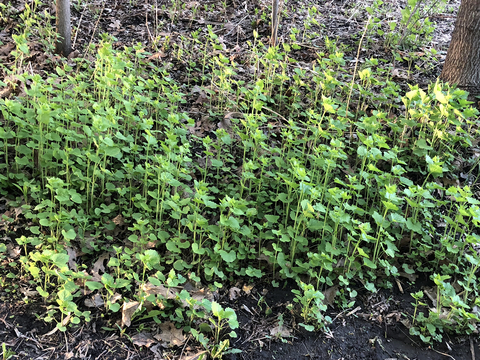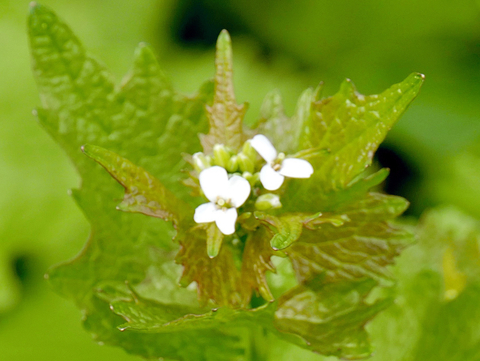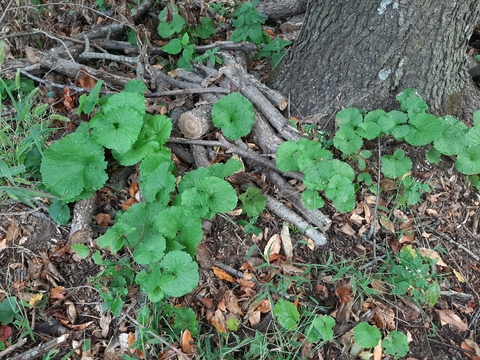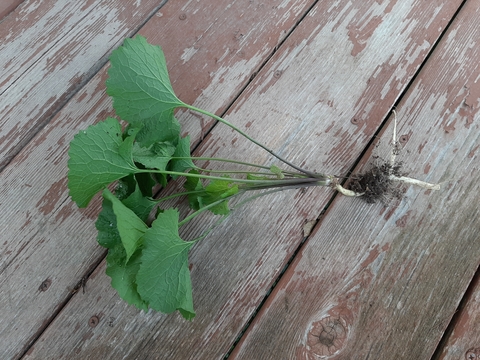Quick facts
- Garlic mustard is a noxious weed that spreads primarily by seed.
- Garlic mustard grows in mounds and has clusters of small white flowers and scalloped green leaves that smell like garlic when crushed.
- You can remove small sections of garlic mustard in lawns and gardens by hand digging.
- Large infestations may require chemical control in early spring or late fall to avoid harming non-targeted species.
The Minnesota Department of Agriculture designates garlic mustard as a restricted noxious weed, and the Minnesota Department of Natural Resources defines it as an invasive terrestrial species.
In naturalized areas, garlic mustard should be reported using the Great Lakes Early Detection Network App or EDDMapS Midwest, and like other noxious weeds, should be controlled on-site if possible to minimize spread.
Characteristics
Garlic mustard (Alliaria petiolata) is a member of the Brassica family and is also known by common names such as jack-by-the-hedge and garlicwort.
This noxious weed is an herbaceous biennial (a plant that completes its life cycle in two growing seasons). Typically growing between 2 to 4 feet tall, garlic mustard outcompetes native plant species in woodland regions. When torn or crushed, garlic mustard parts emit a strong garlicky scent.
Flowers, fruit and seeds
- Bloom time: spring to early summer.
- Like all members of the Brassica family, garlic mustard has clusters of small, four-petaled white flowers.
- Flowers grow primarily at stem tips and leaf intersections (axils).
- After flowering, garlic mustard produces 1- to 3-inch slender green capsules (siliques) containing between 100 to 10,000 tiny black seeds.
- Garlic mustard siliques disperse their seeds in late spring, summer, and early fall.
Leaves
- Bright green with a coarsely toothed or scalloped edge.
- During the first year of growth, plants form basal rosettes with scalloped, kidney-shaped leaves.
- During second-year growth, leaves form into heart or triangular shapes with more rigid edges.
- Alternate growth.
Stem and roots
- Garlic mustard typically has a singular weak main stem.
- Garlic mustard has a taproot that curves, forming an S shape, directly under the soil to provide stability to the plant.
Where it thrives
Garlic mustard thrives in disturbed soils and can indicate chemical disturbances or natural disturbances such as flooding or erosion. This weed is a common opportunistic plant and is quick to occupy spaces where vegetation has been removed.
Garlic mustard is most often found in the understories of trees in moist, shaded environments; however, it can grow in most environments due to its high adaptability.
Garlic mustard is suspected to have allelopathic qualities, making it a competitor of desirable plants.
Control and management
Garlic mustard requires committed removal to control its spread. Removal should be done in the spring, before flowering and seed pod formation. Seed capsules release 100 to 10,000 seeds per year. Garlic mustard can continue to set seed after being pulled, so it should be removed before flowering.
Pulled garlic mustard plants with flowers should be burned or bagged and allowed to decompose to minimize seed spread. Disposal of garlic mustard in landfills is illegal and transportation is only allowed to disposal sites and requires proper protection to prevent seed dispersal.
Check with the Minnesota Department of Agriculture (MDA) and Department of Natural Resources (DNR) for further information on safe and legal control.
Turf
- Hand removal is effective for removing small patches but may need to be repeated.
- Remove all parts of the roots and shoots to prevent regrowth.
- A dense and healthy turf is the best defense against garlic mustard encroachment.
- Selective chemical control is most effective when applied in early spring or late fall with minimal damage to grass and sedges.
- Chemical options with minimal damage to grass and sedges include:
- Triclopyr alone
- 2,4-D amine alone
- 2,4-D + dicamba
- Glyphosate is a non-selective herbicide and should be applied in early spring and late fall when other plants are dormant.
Garden
- Garlic mustard can be prevented by cleaning tools and clothes before use.
- Hand removal is effective for removing small patches but may need to be repeated.
- Remove all parts of the roots and shoots to prevent regrowth.
- Fill spaces where garlic mustard is removed as soon as possible with appropriate plant species. Find more ideas for plant selection.
- Broadleaf herbicides are effective on large patches but should be used cautiously to avoid damaging desired garden plants.
Benefits to the landscape
Planting or propagating garlic mustard in Minnesota landscapes is illegal.
Existing plants are edible and are noted by foragers such as the Forager Chef and Four Season Foraging.
Conservation, invasive status, and native status
- Restricted Noxious Weed.
- Invasive.
- Introduced.
- Garlic mustard originates from Europe, Africa, and Asia. The introduction of the plant to the United States as a medicinal and edible plant can be traced back to the 1800s.
Plants that look similar
- Wild ginger
- Violets
- Crinkleroot
- Creeping Charlie
Management strategies for natural areas and large plant populations
Preventing the introduction and spread of garlic mustard to new locations is the most effective form of management. Seed is spread primarily by gravity, but it can be carried to new locations by people and wildlife, such as in seed mixes or soil attached to boots. Thoroughly cleaning shoes, clothing and equipment after hiking is good practice, as is buying seed from reputable sources.
For more information about prevention visit PlayCleanGo. Most importantly, make sure you spread the word about prevention to others.
The UMN Extension Prioritizing Invasive Plant Control worksheet can help you identify high-priority management areas, and the Invasive Plant Management Decision Analysis Tool can help you determine the long-term feasibility of management on a site. Land managers may also find the Garlic Mustard Management Decision Tree from the Midwest Invasive Plant Network a good resource.
The best time for physical removal is early spring when plants are in bud or full flower, and before seed pods (siliques) begin to form. However, it is easiest to scout for garlic mustard rosettes in the late fall, as it is one of the last green plants in the woods. Take that opportunity to identify and map priority management populations for spring removal.
Monitoring for and placing the highest management priority on satellite populations or newly colonized areas helps prevent garlic mustard populations from expanding to sizes that are challenging to manage. It also helps to preserve normal soil nutrient cycling, prevents seed bank formation, reduces disruption to the microbiotic communities of forest soils, and minimizes earthworm populations.
Researchers have observed a resurgence in garlic mustard when competing vegetation is removed during ecosystem restoration. Garlic mustard also thrives with natural disturbances, such as those caused by low land flooding and overbrowsing of native species by deer. If possible, exclude or manage overabundant deer populations in the area, and plant native vegetation in areas where disturbance has occurred.
Only attempt to manage long-standing, dense infestations when a long-term annual commitment to management is possible.
- Remove 90% or more of the site’s flowering plants and rosettes each year.
- Recheck for missed plants during peak flowering weeks. A single large plant can produce over a thousand seeds.
- Revegetate with native species once garlic mustard is under control and the native seed bank is depleted.
While declines have been observed at some long-invaded sites, it is not clear how widespread or enduring these declines will be. Monitor infestations that are not being managed, and if garlic mustard declines, fill the space with native vegetation and monitor for its success to prevent garlic mustard seedlings from filling the opening.
A handy checklist for managing volunteers can be found in the UMN Extension Invasive Species Project Planner document. Provide structure and guidance for volunteer events so that the following conditions are met:
- Be a smart recruiter. The number of volunteers for your event should be suitable to the site and size of the infestation being managed. Garlic mustard pulls are also a great event for all ages.
- Provide training. Make sure volunteers can properly identify garlic mustard and common native species. If using herbicide, train volunteers on safe handling practices.
- Leave no trace. Minimize impacts on natural spaces. Space volunteers far enough apart to prevent trampling of native plants and excessive soil disturbance
- WorkCleanGo. Volunteers should brush all mud and plant materials from their shoes before leaving invaded areas.
Document your work by taking photographs before and after garlic mustard management. Seeing changes can be a great motivation for you to keep working on long-term restoration projects!
Cipollini, D., Rigsby, C. M., & Barto, E. K. (2012). Microbes as targets and mediators of allelopathy in plants. Journal of Chemical Ecology, 38(6), 714-727.
Cosme, M., Fernández, I., Van der Heijden, M. G., & Pieterse, C. M. (2018). Non-mycorrhizal plants: the exceptions that prove the rule. Trends in plant science, 23(7), 577-587.
Durka, W., Bossdorf, O., Prati, D., & Auge, H. (2005). Molecular evidence for multiple introductions of garlic mustard (Alliaria petiolata, Brassicaceae) to North America. Molecular ecology, 14(6), 1697-1706.
Michigan Department of Natural Resources. (2018). Garlic Mustard. Michigan Natural Features Inventory. https://mnfi.anr.msu.edu/invasive-species/GarlicMustardBCP.pdf
Prati, D., & Bossdorf, O. (2004). Allelopathic inhibition of germination by Alliaria petiolata (Brassicaceae). American Journal of Botany, 91(2), 285-288.
Saul, H., Madella, M., Fischer, A., Glykou, A., Hartz, S., & Craig, O. E. (2013). Phytoliths in pottery reveal the use of spice in European prehistoric cuisine. PLoS One, 8(8), e70583.
Reviewed in 2024





